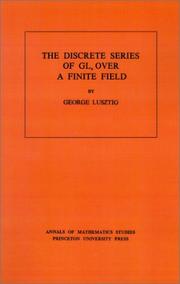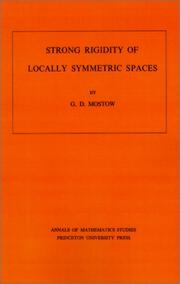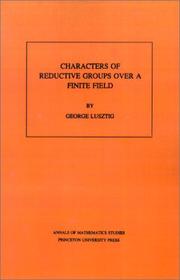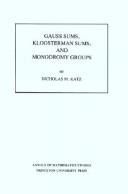| Listing 1 - 8 of 8 |
Sort by
|

ISBN: 0691081549 1400881765 9780691081540 Year: 1974 Volume: 81 Publisher: Princeton (N.J.): Princeton university press
Abstract | Keywords | Export | Availability | Bookmark
 Loading...
Loading...Choose an application
- Reference Manager
- EndNote
- RefWorks (Direct export to RefWorks)
In this book Professor Lusztig solves an interesting problem by entirely new methods: specifically, the use of cohomology of buildings and related complexes.The book gives an explicit construction of one distinguished member, D(V), of the discrete series of GLn (Fq), where V is the n-dimensional F-vector space on which GLn(Fq) acts. This is a p-adic representation; more precisely D(V) is a free module of rank (q--1) (q2-1)...(qn-1-1) over the ring of Witt vectors WF of F. In Chapter 1 the author studies the homology of partially ordered sets, and proves some vanishing theorems for the homology of some partially ordered sets associated to geometric structures. Chapter 2 is a study of the representation △ of the affine group over a finite field. In Chapter 3 D(V) is defined, and its restriction to parabolic subgroups is determined. In Chapter 4 the author computes the character of D(V), and shows how to obtain other members of the discrete series by applying Galois automorphisms to D(V). Applications are in Chapter 5. As one of the main applications of his study the author gives a precise analysis of a Brauer lifting of the standard representation of GLn(Fq).
Group theory --- Algebraic fields --- Linear algebraic groups --- Representations of groups --- Series --- 511.33 --- Algebra --- Mathematics --- Processes, Infinite --- Sequences (Mathematics) --- Group representation (Mathematics) --- Groups, Representation theory of --- Algebraic groups, Linear --- Geometry, Algebraic --- Algebraic varieties --- Algebraic number fields --- Algebraic numbers --- Fields, Algebraic --- Algebra, Abstract --- Algebraic number theory --- Rings (Algebra) --- Analytical and multiplicative number theory. Asymptotics. Sieves etc. --- Algebraic fields. --- Linear algebraic groups. --- Representations of groups. --- Series. --- 511.33 Analytical and multiplicative number theory. Asymptotics. Sieves etc. --- Analytical and multiplicative number theory. Asymptotics. Sieves etc --- Addition. --- Affine group. --- Automorphism. --- Dimension. --- Eigenvalues and eigenvectors. --- Endomorphism. --- Field of fractions. --- Finite field. --- Free module. --- Grothendieck group. --- Homomorphism. --- Linear subspace. --- Morphism. --- P-adic number. --- Partially ordered set. --- Simplicial complex. --- Tensor product. --- Theorem. --- Witt vector. --- Groupes algébriques linéaires --- Groupes algébriques linéaires --- Représentations de groupes

ISBN: 0691081360 1400881838 9780691081366 Year: 1973 Volume: 78 Publisher: Princeton (N.J.): Princeton university press,
Abstract | Keywords | Export | Availability | Bookmark
 Loading...
Loading...Choose an application
- Reference Manager
- EndNote
- RefWorks (Direct export to RefWorks)
Locally symmetric spaces are generalizations of spaces of constant curvature. In this book the author presents the proof of a remarkable phenomenon, which he calls "strong rigidity": this is a stronger form of the deformation rigidity that has been investigated by Selberg, Calabi-Vesentini, Weil, Borel, and Raghunathan.The proof combines the theory of semi-simple Lie groups, discrete subgroups, the geometry of E. Cartan's symmetric Riemannian spaces, elements of ergodic theory, and the fundamental theorem of projective geometry as applied to Tit's geometries. In his proof the author introduces two new notions having independent interest: one is "pseudo-isometries"; the other is a notion of a quasi-conformal mapping over the division algebra K (K equals real, complex, quaternion, or Cayley numbers). The author attempts to make the account accessible to readers with diverse backgrounds, and the book contains capsule descriptions of the various theories that enter the proof.
Differential geometry. Global analysis --- Riemannian manifolds --- Symmetric spaces --- Rigidity (Geometry) --- 512 --- Lie groups --- Geometric rigidity --- Rigidity theorem --- Discrete geometry --- Spaces, Symmetric --- Geometry, Differential --- Manifolds, Riemannian --- Riemannian space --- Space, Riemannian --- Manifolds (Mathematics) --- Groups, Lie --- Lie algebras --- Topological groups --- Algebra --- Lie groups. --- Riemannian manifolds. --- Symmetric spaces. --- Rigidity (Geometry). --- 512 Algebra --- Addition. --- Adjoint representation. --- Affine space. --- Approximation. --- Automorphism. --- Axiom. --- Big O notation. --- Boundary value problem. --- Cohomology. --- Compact Riemann surface. --- Compact space. --- Conjecture. --- Constant curvature. --- Corollary. --- Counterexample. --- Covering group. --- Covering space. --- Curvature. --- Diameter. --- Diffeomorphism. --- Differentiable function. --- Dimension. --- Direct product. --- Division algebra. --- Ergodicity. --- Erlangen program. --- Existence theorem. --- Exponential function. --- Finitely generated group. --- Fundamental domain. --- Fundamental group. --- Geometry. --- Half-space (geometry). --- Hausdorff distance. --- Hermitian matrix. --- Homeomorphism. --- Homomorphism. --- Hyperplane. --- Identity matrix. --- Inner automorphism. --- Isometry group. --- Jordan algebra. --- Matrix multiplication. --- Metric space. --- Morphism. --- Möbius transformation. --- Normal subgroup. --- Normalizing constant. --- Partially ordered set. --- Permutation. --- Projective space. --- Riemann surface. --- Riemannian geometry. --- Sectional curvature. --- Self-adjoint. --- Set function. --- Smoothness. --- Stereographic projection. --- Subgroup. --- Subset. --- Summation. --- Symmetric space. --- Tangent space. --- Tangent vector. --- Theorem. --- Topology. --- Tubular neighborhood. --- Two-dimensional space. --- Unit sphere. --- Vector group. --- Weyl group. --- Riemann, Variétés de --- Lie, Groupes de --- Geometrie differentielle globale --- Varietes riemanniennes

ISBN: 0691086869 0691086850 1400837219 1322063214 9781400837212 9780691086866 9780691086859 Year: 2001 Volume: 148 Publisher: Princeton Princeton University Press
Abstract | Keywords | Export | Availability | Bookmark
 Loading...
Loading...Choose an application
- Reference Manager
- EndNote
- RefWorks (Direct export to RefWorks)
The first two chapters of this book offer a modern, self-contained exposition of the elementary theory of triangulated categories and their "ients. The simple, elegant presentation of these known results makes these chapters eminently suitable as a text for graduate students. The remainder of the book is devoted to new research, providing, among other material, some remarkable improvements on Brown's classical representability theorem. In addition, the author introduces a class of triangulated categories"--the "well generated triangulated categories"--and studies their properties. This exercise is particularly worthwhile in that many examples of triangulated categories are well generated, and the book proves several powerful theorems for this broad class. These chapters will interest researchers in the fields of algebra, algebraic geometry, homotopy theory, and mathematical physics.
Categories (Mathematics). --- Category theory. Homological algebra --- Categories (Mathematics) --- 512.58 --- 512.58 Categories. Category theory --- Categories. Category theory --- Category theory (Mathematics) --- Algebra, Homological --- Algebra, Universal --- Group theory --- Logic, Symbolic and mathematical --- Topology --- Functor theory --- Abelian category. --- Abelian group. --- Additive category. --- Adjoint functors. --- Adjoint. --- Adjunction (field theory). --- Associative property. --- Axiom. --- Basis (linear algebra). --- Bijection. --- Biproduct. --- Brown's representability theorem. --- Cardinal number. --- Cardinality. --- Category of abelian groups. --- Chain complex. --- Class (set theory). --- Cohomology. --- Computation. --- Coproduct. --- Corollary. --- Countable set. --- Counterexample. --- Derived category. --- Derived functor. --- Diagram (category theory). --- Direct limit. --- Direct sum. --- Discrete valuation ring. --- Duality (mathematics). --- Embedding. --- Equivalence class. --- Equivalence of categories. --- Exact functor. --- Exact sequence. --- Existence theorem. --- Existential quantification. --- Factorization. --- Finitely generated abelian group. --- Functor category. --- Functor. --- Grothendieck category. --- Grothendieck's Tôhoku paper. --- Group homomorphism. --- Homological algebra. --- Homotopy category of chain complexes. --- Homotopy category. --- Homotopy colimit. --- Homotopy. --- I0. --- Injective function. --- Injective object. --- Integer. --- Isomorph. --- Isomorphism class. --- Jack Morava. --- K-theory. --- Limit (category theory). --- Limit of a sequence. --- Limit ordinal. --- Linear map. --- Mapping cone (homological algebra). --- Mathematical induction. --- Maximal ideal. --- Module (mathematics). --- Monomorphism. --- Moore space. --- Morphism. --- N0. --- Natural transformation. --- Open set. --- Partially ordered set. --- Pierre Deligne. --- Prime number. --- Projective object. --- Proportionality (mathematics). --- Quotient category. --- Regular cardinal. --- Representable functor. --- Sheaf (mathematics). --- Special case. --- Spectral sequence. --- Subcategory. --- Subobject. --- Subsequence. --- Subset. --- Successor ordinal. --- Summation. --- Tautology (logic). --- Tensor product. --- Theorem. --- Theory. --- Topological group. --- Transfinite induction. --- Transfinite. --- Triangulated category. --- Universal property. --- Vector space. --- Vladimir Voevodsky. --- Yoneda lemma.
Book
ISBN: 0691079994 1400881986 9780691079998 Year: 1971 Volume: 38 Publisher: Princeton (N.J.): Princeton university press,
Abstract | Keywords | Export | Availability | Bookmark
 Loading...
Loading...Choose an application
- Reference Manager
- EndNote
- RefWorks (Direct export to RefWorks)
The description for this book, Linear Inequalities and Related Systems. (AM-38), Volume 38, will be forthcoming.
Operational research. Game theory --- Linear programming. --- Matrices. --- Game theory. --- Games, Theory of --- Theory of games --- Mathematical models --- Mathematics --- Algebra, Matrix --- Cracovians (Mathematics) --- Matrix algebra --- Matrixes (Algebra) --- Algebra, Abstract --- Algebra, Universal --- Production scheduling --- Programming (Mathematics) --- Banach space. --- Basic solution (linear programming). --- Big O notation. --- Bilinear form. --- Boundary (topology). --- Brouwer fixed-point theorem. --- Characterization (mathematics). --- Coefficient. --- Combination. --- Computation. --- Computational problem. --- Convex combination. --- Convex cone. --- Convex hull. --- Convex set. --- Corollary. --- Correlation and dependence. --- Cramer's rule. --- Cyclic permutation. --- Dedekind cut. --- Degeneracy (mathematics). --- Determinant. --- Diagram (category theory). --- Dilworth's theorem. --- Dimension (vector space). --- Directional derivative. --- Disjoint sets. --- Doubly stochastic matrix. --- Dual space. --- Duality (mathematics). --- Duality (optimization). --- Eigenvalues and eigenvectors. --- Elementary proof. --- Equation solving. --- Equation. --- Equivalence class. --- Euclidean space. --- Existence theorem. --- Existential quantification. --- Extreme point. --- Fixed-point theorem. --- Functional analysis. --- Fundamental theorem. --- General equilibrium theory. --- Hall's theorem. --- Hilbert space. --- Incidence matrix. --- Inequality (mathematics). --- Infimum and supremum. --- Invertible matrix. --- Kakutani fixed-point theorem. --- Lagrange multiplier. --- Linear equation. --- Linear inequality. --- Linear map. --- Linear space (geometry). --- Linear subspace. --- Loss function. --- Main diagonal. --- Mathematical induction. --- Mathematical optimization. --- Mathematical problem. --- Max-flow min-cut theorem. --- Maxima and minima. --- Maximal set. --- Maximum flow problem. --- Menger's theorem. --- Minor (linear algebra). --- Monotonic function. --- N-vector. --- Nonlinear programming. --- Nonnegative matrix. --- Parity (mathematics). --- Partially ordered set. --- Permutation matrix. --- Permutation. --- Polyhedron. --- Quantity. --- Representation theorem. --- Row and column vectors. --- Scientific notation. --- Sensitivity analysis. --- Set notation. --- Sign (mathematics). --- Simplex algorithm. --- Simultaneous equations. --- Solution set. --- Special case. --- Subset. --- Summation. --- System of linear equations. --- Theorem. --- Transpose. --- Unit sphere. --- Unit vector. --- Upper and lower bounds. --- Variable (mathematics). --- Vector space. --- Von Neumann's theorem.

ISBN: 0691083509 0691083517 1400881773 9780691083513 9780691083506 Year: 1984 Volume: 107 Publisher: Princeton, N.J.
Abstract | Keywords | Export | Availability | Bookmark
 Loading...
Loading...Choose an application
- Reference Manager
- EndNote
- RefWorks (Direct export to RefWorks)
This book presents a classification of all (complex)irreducible representations of a reductive group withconnected centre, over a finite field. To achieve this,the author uses etale intersection cohomology, anddetailed information on representations of Weylgroups.
512 --- Characters of groups --- Finite fields (Algebra) --- Finite groups --- Groups, Finite --- Group theory --- Modules (Algebra) --- Modular fields (Algebra) --- Algebra, Abstract --- Algebraic fields --- Galois theory --- Characters, Group --- Group characters --- Groups, Characters of --- Representations of groups --- Rings (Algebra) --- Algebra --- 512 Algebra --- Finite groups. --- Characters of groups. --- Addition. --- Algebra representation. --- Algebraic closure. --- Algebraic group. --- Algebraic variety. --- Algebraically closed field. --- Bijection. --- Borel subgroup. --- Cartan subalgebra. --- Character table. --- Character theory. --- Characteristic function (probability theory). --- Characteristic polynomial. --- Class function (algebra). --- Classical group. --- Coefficient. --- Cohomology with compact support. --- Cohomology. --- Combination. --- Complex number. --- Computation. --- Conjugacy class. --- Connected component (graph theory). --- Coxeter group. --- Cyclic group. --- Cyclotomic polynomial. --- David Kazhdan. --- Dense set. --- Derived category. --- Diagram (category theory). --- Dimension. --- Direct sum. --- Disjoint sets. --- Disjoint union. --- E6 (mathematics). --- Eigenvalues and eigenvectors. --- Endomorphism. --- Equivalence class. --- Equivalence relation. --- Existential quantification. --- Explicit formula. --- Explicit formulae (L-function). --- Fiber bundle. --- Finite field. --- Finite group. --- Fourier transform. --- Green's function. --- Group (mathematics). --- Group action. --- Group representation. --- Harish-Chandra. --- Hecke algebra. --- Identity element. --- Integer. --- Irreducible representation. --- Isomorphism class. --- Jordan decomposition. --- Line bundle. --- Linear combination. --- Local system. --- Mathematical induction. --- Maximal torus. --- Module (mathematics). --- Monodromy. --- Morphism. --- Orthonormal basis. --- P-adic number. --- Parametrization. --- Parity (mathematics). --- Partially ordered set. --- Perverse sheaf. --- Pointwise. --- Polynomial. --- Quantity. --- Rational point. --- Reductive group. --- Ree group. --- Schubert variety. --- Scientific notation. --- Semisimple Lie algebra. --- Sheaf (mathematics). --- Simple group. --- Simple module. --- Special case. --- Standard basis. --- Subset. --- Subtraction. --- Summation. --- Surjective function. --- Symmetric group. --- Tensor product. --- Theorem. --- Two-dimensional space. --- Unipotent representation. --- Vector bundle. --- Vector space. --- Verma module. --- Weil conjecture. --- Weyl group. --- Zariski topology.
Book
ISBN: 0691145423 0691145415 9780691145419 9780691145426 1282645064 9786612645068 1400835402 9781400835409 Year: 2010 Publisher: Princeton, NJ
Abstract | Keywords | Export | Availability | Bookmark
 Loading...
Loading...Choose an application
- Reference Manager
- EndNote
- RefWorks (Direct export to RefWorks)
Ramsey theory is a fast-growing area of combinatorics with deep connections to other fields of mathematics such as topological dynamics, ergodic theory, mathematical logic, and algebra. The area of Ramsey theory dealing with Ramsey-type phenomena in higher dimensions is particularly useful. Introduction to Ramsey Spaces presents in a systematic way a method for building higher-dimensional Ramsey spaces from basic one-dimensional principles. It is the first book-length treatment of this area of Ramsey theory, and emphasizes applications for related and surrounding fields of mathematics, such as set theory, combinatorics, real and functional analysis, and topology. In order to facilitate accessibility, the book gives the method in its axiomatic form with examples that cover many important parts of Ramsey theory both finite and infinite. An exciting new direction for combinatorics, this book will interest graduate students and researchers working in mathematical subdisciplines requiring the mastery and practice of high-dimensional Ramsey theory.
Algebraic spaces. --- Ramsey theory. --- Ramsey theory --- Algebraic spaces --- Mathematics --- Algebra --- Physical Sciences & Mathematics --- Spaces, Algebraic --- Geometry, Algebraic --- Combinatorial analysis --- Graph theory --- Analytic set. --- Axiom of choice. --- Baire category theorem. --- Baire space. --- Banach space. --- Bijection. --- Binary relation. --- Boolean prime ideal theorem. --- Borel equivalence relation. --- Borel measure. --- Borel set. --- C0. --- Cantor cube. --- Cantor set. --- Cantor space. --- Cardinality. --- Characteristic function (probability theory). --- Characterization (mathematics). --- Combinatorics. --- Compact space. --- Compactification (mathematics). --- Complete metric space. --- Completely metrizable space. --- Constructible universe. --- Continuous function (set theory). --- Continuous function. --- Corollary. --- Countable set. --- Counterexample. --- Decision problem. --- Dense set. --- Diagonalization. --- Dimension (vector space). --- Dimension. --- Discrete space. --- Disjoint sets. --- Dual space. --- Embedding. --- Equation. --- Equivalence relation. --- Existential quantification. --- Family of sets. --- Forcing (mathematics). --- Forcing (recursion theory). --- Gap theorem. --- Geometry. --- Ideal (ring theory). --- Infinite product. --- Lebesgue measure. --- Limit point. --- Lipschitz continuity. --- Mathematical induction. --- Mathematical problem. --- Mathematics. --- Metric space. --- Metrization theorem. --- Monotonic function. --- Natural number. --- Natural topology. --- Neighbourhood (mathematics). --- Null set. --- Open set. --- Order type. --- Partial function. --- Partially ordered set. --- Peano axioms. --- Point at infinity. --- Pointwise. --- Polish space. --- Probability measure. --- Product measure. --- Product topology. --- Property of Baire. --- Ramsey's theorem. --- Right inverse. --- Scalar multiplication. --- Schauder basis. --- Semigroup. --- Sequence. --- Sequential space. --- Set (mathematics). --- Set theory. --- Sperner family. --- Subsequence. --- Subset. --- Subspace topology. --- Support function. --- Symmetric difference. --- Theorem. --- Topological dynamics. --- Topological group. --- Topological space. --- Topology. --- Tree (data structure). --- Unit interval. --- Unit sphere. --- Variable (mathematics). --- Well-order. --- Zorn's lemma.
Book
ISBN: 0691653682 1400875668 9781400875665 9780691079479 9780691627748 0691627746 9780691627748 Year: 2015 Publisher: Princeton, NJ
Abstract | Keywords | Export | Availability | Bookmark
 Loading...
Loading...Choose an application
- Reference Manager
- EndNote
- RefWorks (Direct export to RefWorks)
Book 4 in the Princeton Mathematical Series.Originally published in 1941.The Princeton Legacy Library uses the latest print-on-demand technology to again make available previously out-of-print books from the distinguished backlist of Princeton University Press. These editions preserve the original texts of these important books while presenting them in durable paperback and hardcover editions. The goal of the Princeton Legacy Library is to vastly increase access to the rich scholarly heritage found in the thousands of books published by Princeton University Press since its founding in 1905.
Topology. --- Analysis situs --- Position analysis --- Rubber-sheet geometry --- Geometry --- Polyhedra --- Set theory --- Algebras, Linear --- Abelian group. --- Additive group. --- Adjunction (field theory). --- Algebraic connectivity. --- Algebraic number. --- Annihilator (ring theory). --- Automorphism. --- Barycentric coordinate system. --- Barycentric subdivision. --- Big O notation. --- Boundary (topology). --- Cantor set. --- Cardinal number. --- Cartesian coordinate system. --- Cauchy sequence. --- Character group. --- Circumference. --- Cohomology. --- Combinatorics. --- Compact space. --- Complete metric space. --- Complex number. --- Computation. --- Continuous function (set theory). --- Continuous function. --- Contractible space. --- Cyclic group. --- Dense set. --- Diameter. --- Dimension (vector space). --- Dimension function. --- Dimension theory (algebra). --- Dimension. --- Dimensional analysis. --- Discrete group. --- Disjoint sets. --- Domain of a function. --- Equation. --- Euclidean space. --- Existential quantification. --- Exponentiation. --- Function (mathematics). --- Function space. --- Fundamental theorem. --- Geometry. --- Group theory. --- Hausdorff dimension. --- Hausdorff space. --- Hilbert cube. --- Hilbert space. --- Homeomorphism. --- Homology (mathematics). --- Homomorphism. --- Homotopy. --- Hyperplane. --- Integer. --- Interior (topology). --- Invariance of domain. --- Inverse system. --- Linear space (geometry). --- Linear subspace. --- Lp space. --- Mathematical induction. --- Mathematics. --- Metric space. --- Multiplicative group. --- N-sphere. --- Natural number. --- Natural transformation. --- Ordinal number. --- Orientability. --- Parity (mathematics). --- Partial function. --- Partially ordered set. --- Point (geometry). --- Polytope. --- Projection (linear algebra). --- Samuel Eilenberg. --- Separable space. --- Separated sets. --- Set (mathematics). --- Set theory. --- Sign (mathematics). --- Simplex. --- Special case. --- Subgroup. --- Subsequence. --- Subset. --- Summation. --- Theorem. --- Three-dimensional space (mathematics). --- Topological group. --- Topological property. --- Topological space. --- Transfinite. --- Transitive relation. --- Unit sphere. --- Upper and lower bounds. --- Variable (mathematics).

ISBN: 0691084335 0691084327 1400882125 Year: 1988 Volume: vol 116 Publisher: Princeton, N.J. Princeton University
Abstract | Keywords | Export | Availability | Bookmark
 Loading...
Loading...Choose an application
- Reference Manager
- EndNote
- RefWorks (Direct export to RefWorks)
The study of exponential sums over finite fields, begun by Gauss nearly two centuries ago, has been completely transformed in recent years by advances in algebraic geometry, culminating in Deligne's work on the Weil Conjectures. It now appears as a very attractive mixture of algebraic geometry, representation theory, and the sheaf-theoretic incarnations of such standard constructions of classical analysis as convolution and Fourier transform. The book is simultaneously an account of some of these ideas, techniques, and results, and an account of their application to concrete equidistribution questions concerning Kloosterman sums and Gauss sums.
Group theory --- Algebraic geometry --- Number theory --- 511.33 --- Analytical and multiplicative number theory. Asymptotics. Sieves etc. --- 511.33 Analytical and multiplicative number theory. Asymptotics. Sieves etc. --- Gaussian sums --- Homology theory --- Kloosterman sums --- Monodromy groups --- Kloostermann sums --- Sums, Kloosterman --- Sums, Kloostermann --- Exponential sums --- Cohomology theory --- Contrahomology theory --- Algebraic topology --- Gauss sums --- Sums, Gaussian --- Analytical and multiplicative number theory. Asymptotics. Sieves etc --- Gaussian sums. --- Kloosterman sums. --- Homology theory. --- Monodromy groups. --- Number theory. --- Nombres, Théorie des. --- Exponential sums. --- Sommes exponentielles. --- Arithmetic --- Arithmétique --- Geometry, Algebraic. --- Géométrie algébrique --- Abelian category. --- Absolute Galois group. --- Absolute value. --- Additive group. --- Adjoint representation. --- Affine variety. --- Algebraic group. --- Automorphic form. --- Automorphism. --- Big O notation. --- Cartan subalgebra. --- Characteristic polynomial. --- Classification theorem. --- Coefficient. --- Cohomology. --- Cokernel. --- Combination. --- Commutator. --- Compactification (mathematics). --- Complex Lie group. --- Complex number. --- Conjugacy class. --- Continuous function. --- Convolution theorem. --- Convolution. --- Determinant. --- Diagonal matrix. --- Dimension (vector space). --- Direct sum. --- Dual basis. --- Eigenvalues and eigenvectors. --- Empty set. --- Endomorphism. --- Equidistribution theorem. --- Estimation. --- Exactness. --- Existential quantification. --- Exponential sum. --- Exterior algebra. --- Faithful representation. --- Finite field. --- Finite group. --- Four-dimensional space. --- Frobenius endomorphism. --- Fundamental group. --- Fundamental representation. --- Galois group. --- Gauss sum. --- Homomorphism. --- Integer. --- Irreducibility (mathematics). --- Isomorphism class. --- Kloosterman sum. --- L-function. --- Leray spectral sequence. --- Lie algebra. --- Lie theory. --- Maximal compact subgroup. --- Method of moments (statistics). --- Monodromy theorem. --- Monodromy. --- Morphism. --- Multiplicative group. --- Natural number. --- Nilpotent. --- Open problem. --- P-group. --- Pairing. --- Parameter space. --- Parameter. --- Partially ordered set. --- Perfect field. --- Point at infinity. --- Polynomial ring. --- Prime number. --- Quotient group. --- Representation ring. --- Representation theory. --- Residue field. --- Riemann hypothesis. --- Root of unity. --- Sheaf (mathematics). --- Simple Lie group. --- Skew-symmetric matrix. --- Smooth morphism. --- Special case. --- Spin representation. --- Subgroup. --- Support (mathematics). --- Symmetric matrix. --- Symplectic group. --- Symplectic vector space. --- Tensor product. --- Theorem. --- Trace (linear algebra). --- Trivial representation. --- Variable (mathematics). --- Weil conjectures. --- Weyl character formula. --- Zariski topology.
| Listing 1 - 8 of 8 |
Sort by
|

 Search
Search Feedback
Feedback About UniCat
About UniCat  Help
Help News
News